
Illustrative Math Alignment: Grade 7 Unit 7
Expressions, Equations, and Inequalities
Lesson 9: Dealing with Negative Numbers
Use the following Media4Math resources with this Illustrative Math lesson.
| Thumbnail Image | Title | Body | Curriculum Topic |
|---|---|---|---|
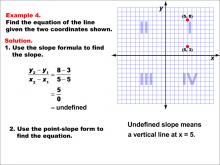
|
Math Example--Linear Function Concepts--The Equation of a Line Given Two Points: Example 4 | Math Example--Linear Function Concepts--The Equation of a Line Given Two Points: Example 4TopicLinear Functions DescriptionThis example illustrates how to find the equation of a vertical line passing through the points (5, 3) and (5, 8). The slope is undefined because both x-coordinates are the same, resulting in division by zero when using the slope formula. This indicates a vertical line, and the equation is simply x = 5. |
Point-Slope Form and Slope-Intercept Form |
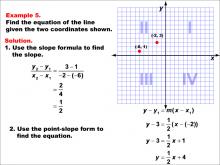
|
Math Example--Linear Function Concepts--The Equation of a Line Given Two Points: Example 5 | Math Example--Linear Function Concepts--The Equation of a Line Given Two Points: Example 5TopicLinear Functions DescriptionThis example demonstrates how to find the equation of a line passing through the points (-6, 1) and (-2, 3). The slope is calculated using the formula (y2 - y1) / (x2 - x1), resulting in a slope of 1/2. Using the point-slope form of a line, y - y1 = m(x - x1), the equation is derived and simplified to y = (1/2)x + 4. |
Point-Slope Form and Slope-Intercept Form |
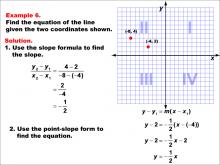
|
Math Example--Linear Function Concepts--The Equation of a Line Given Two Points: Example 6 | Math Example--Linear Function Concepts--The Equation of a Line Given Two Points: Example 6TopicLinear Functions DescriptionThis image shows a graph with two points (-8, 4) and (-4, 2). The slope is calculated as (y2 - y1) / (x2 - x1), resulting in a slope of -1/2. The equation of the line is derived using point-slope form and simplified to y = -(1/2)x. The slope is calculated as -1/2, and the line equation is determined using point-slope form: y = -(1/2)x. |
Point-Slope Form and Slope-Intercept Form |

|
Math Example--Linear Function Concepts--The Equation of a Line Given Two Points: Example 7 | Math Example--Linear Function Concepts--The Equation of a Line Given Two Points: Example 7TopicLinear Functions DescriptionThis image shows a graph with two points (-7, 5) and (-1, 5). The slope is calculated as zero since the y-values are equal. The equation of the line is horizontal, simplified to y = 5. The slope is 0, indicating a horizontal line. The equation is y = 5. |
Point-Slope Form and Slope-Intercept Form |

|
Math Example--Linear Function Concepts--The Equation of a Line Given Two Points: Example 8 | Math Example--Linear Function Concepts--The Equation of a Line Given Two Points: Example 8TopicLinear Functions DescriptionThis image shows a graph with two points (-5, 6) and (-5, 3). The slope is undefined because the x-values are equal. This results in a vertical line at x = -5. The slope is undefined, indicating a vertical line at x = -5. |
Point-Slope Form and Slope-Intercept Form |
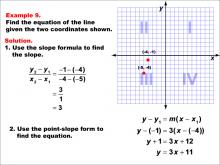
|
Math Example--Linear Function Concepts--The Equation of a Line Given Two Points: Example 9 | Math Example--Linear Function Concepts--The Equation of a Line Given Two Points: Example 9TopicLinear Functions DescriptionThe image shows a coordinate plane with two points (-5, -4) and (-4, -1) marked. It provides a step-by-step solution to find the equation of the line passing through these points. The slope is calculated, and the equation is derived using point-slope form. The slope is calculated as (y2 - y1) / (x2 - x1) = (-1 - (-4)) / (-4 - (-5)) = 3 / 1 = 3. Using point-slope form, y - y1 = m(x - x1), the equation is derived as y + 1 = 3(x + 4), which simplifies to y = 3x + 11. |
Point-Slope Form and Slope-Intercept Form |
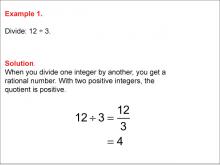
|
Math Example--Numerical Expressions--Dividing Integers: Example 1 | Math Example--Numerical Expressions--Dividing Integers: Example 1TopicNumerical Expressions DescriptionThis example demonstrates the division of two positive integers: 12 divided by 3. The solution shows that when dividing one integer by another, the result is a rational number. In this case, with two positive integers, the quotient is positive. The calculation is presented as 12 ÷ 3 = 12 / 3 = 4. |
Numerical Expressions |
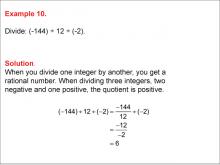
|
Math Example--Numerical Expressions--Dividing Integers: Example 10 | Math Example--Numerical Expressions--Dividing Integers: Example 10TopicNumerical Expressions DescriptionThis example demonstrates the division of three integers: (-144) ÷ 12 ÷ (-2). The solution shows that dividing three integers, two negative and one positive, results in a positive quotient. The calculation is presented step-by-step: (-144) ÷ 12 ÷ (-2) = -12 / -2 = 6. |
Numerical Expressions |

|
Math Example--Numerical Expressions--Dividing Integers: Example 11 | Math Example--Numerical Expressions--Dividing Integers: Example 11TopicNumerical Expressions DescriptionThis example demonstrates the division of three integers: (-150) ÷ (-5) ÷ 3. The solution shows that dividing three integers, two negative and one positive, results in a positive quotient. The calculation is presented step-by-step: (-150) ÷ (-5) ÷ 3 = 30 / 3 = 10. |
Numerical Expressions |

|
Math Example--Numerical Expressions--Dividing Integers: Example 12 | Math Example--Numerical Expressions--Dividing Integers: Example 12TopicNumerical Expressions DescriptionThis example illustrates the division of three negative integers: -108 ÷ (-2) ÷ (-6). The solution demonstrates that dividing three negative integers results in a negative quotient. The calculation is presented step-by-step: (-108 / -2) / -6 = 54 / -6 = -9. |
Numerical Expressions |
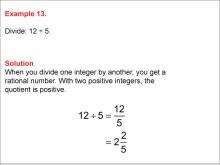
|
Math Example--Numerical Expressions--Dividing Integers: Example 13 | Math Example--Numerical Expressions--Dividing Integers: Example 13TopicNumerical Expressions DescriptionThis example demonstrates the division of two positive integers: 12 ÷ 5. The solution shows that dividing two positive integers results in a positive quotient, which in this case is a mixed number. The calculation is presented as: 12 / 5 = 2 2/5. |
Numerical Expressions |
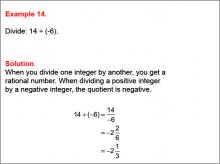
|
Math Example--Numerical Expressions--Dividing Integers: Example 14 | Math Example--Numerical Expressions--Dividing Integers: Example 14TopicNumerical Expressions DescriptionThis example illustrates the division of a positive integer by a negative integer: 14 ÷ (-6). The solution demonstrates that dividing a positive by a negative results in a negative quotient, which in this case is a mixed number. The calculation is presented as: 14 / -6 = -2 1/3. |
Numerical Expressions |
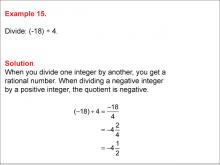
|
Math Example--Numerical Expressions--Dividing Integers: Example 15 | Math Example--Numerical Expressions--Dividing Integers: Example 15TopicNumerical Expressions DescriptionThis example demonstrates the division of a negative integer by a positive integer: -18 ÷ 4. The solution shows that dividing a negative by a positive results in a negative quotient, which in this case is a fraction. The calculation is presented as: -18 / 4 = -9/2 = -4 1/2. |
Numerical Expressions |
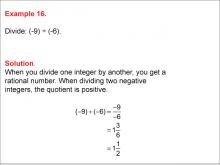
|
Math Example--Numerical Expressions--Dividing Integers: Example 16 | Math Example--Numerical Expressions--Dividing Integers: Example 16TopicNumerical Expressions DescriptionThis example illustrates the division of two negative integers: (-9) ÷ (-6). The solution demonstrates that dividing two negative integers results in a positive fraction. The calculation is presented step-by-step: (-9) ÷ (-6) = -9 / -6 = -3 / -2 = 1 1/2. |
Numerical Expressions |
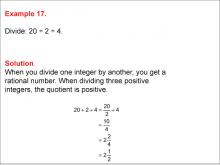
|
Math Example--Numerical Expressions--Dividing Integers: Example 17 | Math Example--Numerical Expressions--Dividing Integers: Example 17TopicNumerical Expressions DescriptionThis example demonstrates the division of three positive integers: 20 ÷ 2 ÷ 4. The solution shows that dividing three positive integers results in a positive mixed number quotient. The calculation is presented step-by-step: 20 ÷ 2 ÷ 4 = 20 / 2 / 4 = 10 / 4 = 2 1/2. |
Numerical Expressions |

|
Math Example--Numerical Expressions--Dividing Integers: Example 18 | Math Example--Numerical Expressions--Dividing Integers: Example 18TopicNumerical Expressions DescriptionThis example illustrates the division of three integers: 48 ÷ 6 ÷ (-3). The solution demonstrates that dividing two positive integers and one negative integer results in a negative mixed number quotient. The calculation is presented step-by-step: 48 ÷ 6 ÷ (-3) = 48 / 6 / (-3) = 8 / (-3) = -2 2/3. |
Numerical Expressions |
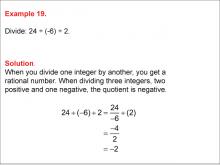
|
Math Example--Numerical Expressions--Dividing Integers: Example 19 | Math Example--Numerical Expressions--Dividing Integers: Example 19TopicNumerical Expressions DescriptionThis example demonstrates the division of three integers: 24 ÷ (-6) ÷ 2. The solution shows that dividing two positive integers and one negative integer results in a negative quotient. The calculation is presented step-by-step: 24 ÷ (-6) ÷ 2 = 24 / (-6) / (2) = -4 / 2 = -2. |
Numerical Expressions |
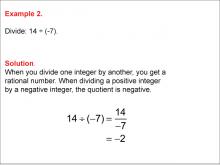
|
Math Example--Numerical Expressions--Dividing Integers: Example 2 | Math Example--Numerical Expressions--Dividing Integers: Example 2TopicNumerical Expressions DescriptionThis example illustrates the division of a positive integer by a negative integer: 14 divided by -7. The solution demonstrates that when dividing one integer by another, the result is a rational number. In this case, when dividing a positive integer by a negative integer, the quotient is negative. The calculation is presented as 14 ÷ (-7) = 14 / -7 = -2. |
Numerical Expressions |
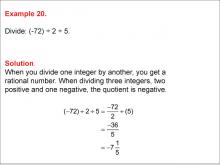
|
Math Example--Numerical Expressions--Dividing Integers: Example 20 | Math Example--Numerical Expressions--Dividing Integers: Example 20TopicNumerical Expressions DescriptionThis example demonstrates the division of three integers: (-72) / 2 / 5. The solution shows that dividing a negative integer by two positive integers results in a negative mixed number quotient. The calculation is presented step-by-step: (-72) / 2 / 5 = -72 / (2 * 5) = -36 / 5 = -7 1/5. |
Numerical Expressions |
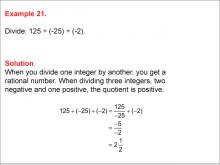
|
Math Example--Numerical Expressions--Dividing Integers: Example 21 | Math Example--Numerical Expressions--Dividing Integers: Example 21TopicNumerical Expressions DescriptionThis example demonstrates the division of three integers: 125 / (-25) / (-2). The solution shows that dividing a positive integer by two negative integers results in a positive mixed number quotient. The calculation is presented step-by-step: 125 / (-25) / (-2) = 125 / (25 * -2) = -5 / -2 = 2 1/2. |
Numerical Expressions |
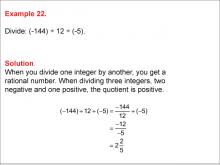
|
Math Example--Numerical Expressions--Dividing Integers: Example 22 | Math Example--Numerical Expressions--Dividing Integers: Example 22TopicNumerical Expressions DescriptionThis example illustrates the division of three integers: (-144) / 12 / (-5). The solution demonstrates that dividing a negative integer by a positive integer and then by a negative integer results in a positive fraction. The calculation is presented step-by-step: (-144) / 12 / (-5) = -144 / (12 * -5) = -12 / -5 = 2 2/5. |
Numerical Expressions |
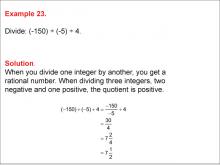
|
Math Example--Numerical Expressions--Dividing Integers: Example 23 | Math Example--Numerical Expressions--Dividing Integers: Example 23TopicNumerical Expressions DescriptionThis example demonstrates the division of three integers: (-150) / (-5) / 4. The solution shows that dividing a negative integer by a negative integer and then by a positive integer results in a positive mixed number quotient. The calculation is presented step-by-step: (-150) / (-5) / 4 = -150 / -5 / 4 = 30 / 4 = 7 1/2. |
Numerical Expressions |
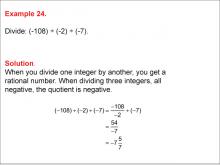
|
Math Example--Numerical Expressions--Dividing Integers: Example 24 | Math Example--Numerical Expressions--Dividing Integers: Example 24TopicNumerical Expressions DescriptionThis example illustrates the division of three negative integers: (-108) ÷ (-2) ÷ (-7). The solution demonstrates that dividing three negative integers results in a negative mixed number quotient. The calculation is presented step-by-step: (-108) ÷ (-2) ÷ (-7) = -108 / -2 ÷ (-7) = 54 / -7 = -7 5/7. |
Numerical Expressions |

|
Math Example--Numerical Expressions--Dividing Integers: Example 3 | Math Example--Numerical Expressions--Dividing Integers: Example 3TopicNumerical Expressions DescriptionThis example demonstrates the division of a negative integer by a positive integer: -18 divided by 6. The solution shows that when dividing one integer by another, the result is a rational number. In this case, when dividing a negative integer by a positive integer, the quotient is negative. The calculation is presented as (-18) ÷ 6 = -18 / 6 = -3. |
Numerical Expressions |
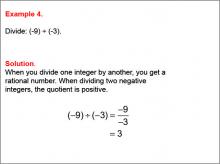
|
Math Example--Numerical Expressions--Dividing Integers: Example 4 | Math Example--Numerical Expressions--Dividing Integers: Example 4TopicNumerical Expressions DescriptionThis example illustrates the division of two negative integers: -9 divided by -3. The solution demonstrates that when dividing one integer by another, the result is a rational number. In this case, when dividing two negative integers, the quotient is positive. The calculation is presented as (-9) ÷ (-3) = -9 / -3 = 3. |
Numerical Expressions |
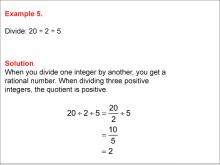
|
Math Example--Numerical Expressions--Dividing Integers: Example 5 | Math Example--Numerical Expressions--Dividing Integers: Example 5TopicNumerical Expressions DescriptionThis example demonstrates the division of three positive integers: 20 ÷ 2 ÷ 5. The solution shows that dividing three positive integers results in a positive quotient. The calculation is presented step-by-step: 20 ÷ 2 ÷ 5 = 20 / 2 ÷ 5 = 10 / 5 = 2. |
Numerical Expressions |

|
Math Example--Numerical Expressions--Dividing Integers: Example 6 | Math Example--Numerical Expressions--Dividing Integers: Example 6TopicNumerical Expressions DescriptionThis example demonstrates the division of three integers: 48 ÷ 6 ÷ (-4). The solution shows that dividing three integers, two positive and one negative, results in a negative quotient. The calculation is presented step-by-step: 48 ÷ 6 ÷ (-4) = 48 / 6 ÷ (-4) = 8 / -4 = -2. |
Numerical Expressions |
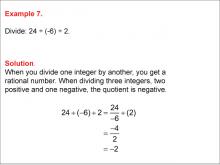
|
Math Example--Numerical Expressions--Dividing Integers: Example 7 | Math Example--Numerical Expressions--Dividing Integers: Example 7TopicNumerical Expressions DescriptionThis example illustrates the division of three integers: 24 ÷ (-6) ÷ 2. The solution demonstrates that dividing three integers, two positive and one negative, results in a negative quotient. The calculation is presented step-by-step: 24 ÷ (-6) ÷ 2 = -4 / 2 = -2. |
Numerical Expressions |
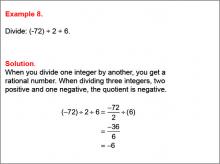
|
Math Example--Numerical Expressions--Dividing Integers: Example 8 | Math Example--Numerical Expressions--Dividing Integers: Example 8TopicNumerical Expressions DescriptionThis example demonstrates the division of three integers: (-72) ÷ 2 ÷ 6. The solution shows that dividing three integers, two positive and one negative, results in a negative quotient. The calculation is presented step-by-step: (-72) ÷ 2 ÷ 6 = -72 / 2 ÷ 6 = -36 / 6 = -6. |
Numerical Expressions |
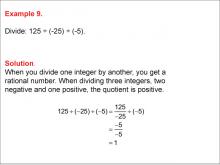
|
Math Example--Numerical Expressions--Dividing Integers: Example 9 | Math Example--Numerical Expressions--Dividing Integers: Example 9TopicNumerical Expressions DescriptionThis example illustrates the division of three integers: 125 ÷ (-25) ÷ (-5). The solution demonstrates that dividing three integers, two negative and one positive, results in a positive quotient. The calculation is presented step-by-step: 125 ÷ (-25) ÷ (-5) = -5 / -5 = 1. |
Numerical Expressions |
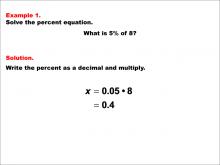
|
Math Example--Percents--Equations with Percents: Example 1 | Math Example--Percents--Equations with Percents: Example 1TopicSolving Equations DescriptionThis math example focuses on solving percent equations, specifically asking "What is 5% of 8?" The solution involves converting 5% to its decimal form, 0.05, and then multiplying it by 8 to get the result of 0.4. This straightforward approach demonstrates how to tackle basic percent calculations efficiently. |
Solving Percent Equations |
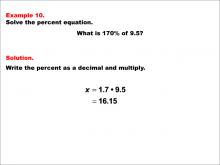
|
Math Example--Percents--Equations with Percents: Example 10 | Math Example--Percents--Equations with Percents: Example 10TopicSolving Equations DescriptionThis math example demonstrates solving percent equations by asking "What is 170% of 9.5?" The solution involves converting 170% to its decimal equivalent, 1.7, and then multiplying it by 9.5 to obtain the result of 16.15. This example combines a percentage greater than 100% with a decimal base number, further illustrating the versatility of the percent-to-decimal conversion method in complex scenarios. |
Solving Percent Equations |
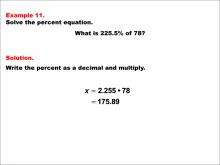
|
Math Example--Percents--Equations with Percents: Example 11 | Math Example--Percents--Equations with Percents: Example 11TopicSolving Equations DescriptionThis math example focuses on solving percent equations, specifically asking "What is 225.5% of 78?" The solution involves converting 225.5% to its decimal form, 2.255, and then multiplying it by 78 to arrive at the answer of 175.89. This example introduces a decimal percentage greater than 200% and a larger whole number as the base value, demonstrating the scalability and flexibility of the percent-to-decimal conversion method in complex scenarios. |
Solving Percent Equations |
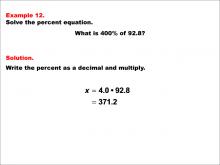
|
Math Example--Percents--Equations with Percents: Example 12 | Math Example--Percents--Equations with Percents: Example 12TopicSolving Equations DescriptionThis math example demonstrates solving percent equations by asking "What is 400% of 92.8?" The solution involves converting 400% to its decimal equivalent, 4.0, and then multiplying it by 92.8 to obtain the result of 371.2. This example showcases how to handle percentages greater than 100% and their application to decimal numbers, illustrating the versatility of the percent-to-decimal conversion method in complex scenarios. |
Solving Percent Equations |
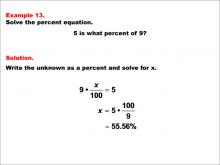
|
Math Example--Percents--Equations with Percents: Example 13 | Math Example--Percents--Equations with Percents: Example 13TopicSolving Equations DescriptionThis math example focuses on solving percent equations by asking "5 is what percent of 9?" The solution involves setting up the equation 9 * (x / 100) = 5, then solving for x to get x = 5 * (100 / 9), which is approximately 55.56%. This example introduces a new type of percent problem where students must find the percentage given two known values. |
Solving Percent Equations |

|
Math Example--Percents--Equations with Percents: Example 14 | Math Example--Percents--Equations with Percents: Example 14TopicSolving Equations DescriptionThis math example demonstrates solving percent equations by asking "6 is what percent of 2.3?" The solution involves setting up the equation 2.3 * (x / 100) = 6, then solving for x to get x = 6 * (100 / 2.3), which is approximately 260.87%. This example introduces a scenario where the resulting percentage is greater than 100% and involves a decimal base number. |
Solving Percent Equations |
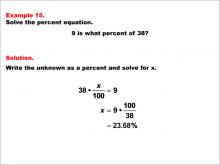
|
Math Example--Percents--Equations with Percents: Example 15 | Math Example--Percents--Equations with Percents: Example 15TopicSolving Equations DescriptionThis math example focuses on solving percent equations by asking "9 is what percent of 38?" The solution involves setting up the equation 38 * (x / 100) = 9, then solving for x to get x = 9 * (100 / 38), which is approximately 23.68%. This example demonstrates how to calculate a percentage when the first number is smaller than the second, resulting in a percentage less than 100%. |
Solving Percent Equations |
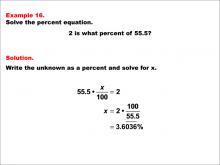
|
Math Example--Percents--Equations with Percents: Example 16 | Math Example--Percents--Equations with Percents: Example 16TopicSolving Equations DescriptionThis math example demonstrates solving percent equations by asking "2 is what percent of 55.5?" The solution involves setting up the equation 55.5 * (x / 100) = 2, then solving for x to get x = 2 * (100 / 55.5), which is approximately 3.6036%. This example introduces a scenario where the resulting percentage is a small fraction, less than 5%, and involves a decimal base number. |
Solving Percent Equations |
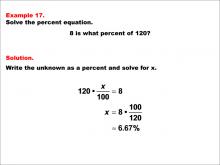
|
Math Example--Percents--Equations with Percents: Example 17 | Math Example--Percents--Equations with Percents: Example 17TopicSolving Equations DescriptionThis math example focuses on solving percent equations by asking "8 is what percent of 120?" The solution involves setting up the equation 120 * (x / 100) = 8, then solving for x to get x = 8 * (100 / 120), which is approximately 6.67%. This example demonstrates how to calculate a percentage when dealing with larger whole numbers, resulting in a percentage less than 10%. |
Solving Percent Equations |

|
Math Example--Percents--Equations with Percents: Example 18 | Math Example--Percents--Equations with Percents: Example 18TopicSolving Equations DescriptionThis math example demonstrates solving percent equations by asking "3.5 is what percent of 350?" The solution involves setting up the equation 350 * (x / 100) = 3.5, then solving for x to get x = 3.5 * (100 / 350), which equals 1%. This example introduces a scenario where the resulting percentage is a whole number (1%) and involves a decimal number as the first value. |
Solving Percent Equations |
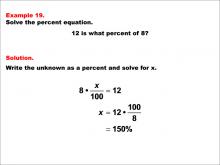
|
Math Example--Percents--Equations with Percents: Example 19 | Math Example--Percents--Equations with Percents: Example 19TopicSolving Equations DescriptionThis math example focuses on solving percent equations by asking "12 is what percent of 8?" The solution involves setting up the equation 8 * (x / 100) = 12, then solving for x to get x = 12 * (100 / 8), which equals 150%. This example demonstrates how to calculate a percentage when the first number is larger than the second, resulting in a percentage greater than 100%. |
Solving Percent Equations |
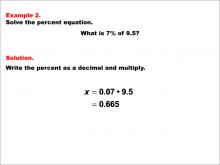
|
Math Example--Percents--Equations with Percents: Example 2 | Math Example--Percents--Equations with Percents: Example 2TopicSolving Equations DescriptionThis math example demonstrates solving percent equations by asking "What is 7% of 9.5?" The solution involves converting 7% to its decimal equivalent, 0.07, and then multiplying it by 9.5 to obtain the result of 0.665. This example builds upon the previous one by introducing a decimal number as the base value. |
Solving Percent Equations |
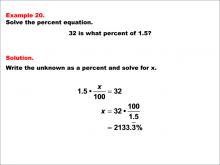
|
Math Example--Percents--Equations with Percents: Example 20 | Math Example--Percents--Equations with Percents: Example 20TopicSolving Equations DescriptionThis math example demonstrates solving percent equations by asking "32 is what percent of 1.5?" The solution involves setting up the equation 1.5 * (x / 100) = 32, then solving for x to get x = 32 * (100 / 1.5), which equals 2133.3%. This example introduces a scenario where the resulting percentage is significantly larger than 100% and involves a decimal base number less than 1. |
Solving Percent Equations |
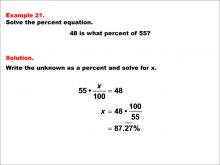
|
Math Example--Percents--Equations with Percents: Example 21 | Math Example--Percents--Equations with Percents: Example 21TopicSolving Equations DescriptionThis math example focuses on solving percent equations by asking "48 is what percent of 55?" The solution involves setting up the equation 55 * (x / 100) = 48, then solving for x to get x = 48 * (100 / 55), which equals 87.27%. This example demonstrates how to calculate a percentage when the two numbers are relatively close in value, resulting in a percentage close to but less than 100%. |
Solving Percent Equations |
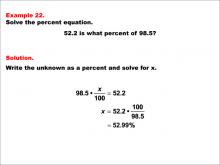
|
Math Example--Percents--Equations with Percents: Example 22 | Math Example--Percents--Equations with Percents: Example 22TopicSolving Equations DescriptionThis math example demonstrates solving percent equations by asking "52.2 is what percent of 98.5?" The solution involves setting up the equation 98.5 * (x / 100) = 52.2, then solving for x to get x = 52.2 * (100 / 98.5), which is approximately 52.99%. This example introduces a scenario where both the numerator and denominator are decimal numbers, resulting in a percentage that is also close to the original numerator. |
Solving Percent Equations |
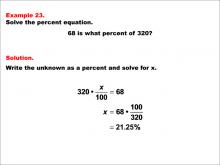
|
Math Example--Percents--Equations with Percents: Example 23 | Math Example--Percents--Equations with Percents: Example 23TopicSolving Equations DescriptionThis math example focuses on solving percent equations by asking "68 is what percent of 320?" The solution involves setting up the equation 320 * (x / 100) = 68, then solving for x to get x = 68 * (100 / 320), which equals 21.25%. This example demonstrates how to calculate a percentage when dealing with whole numbers, resulting in a percentage that's less than 25%. |
Solving Percent Equations |
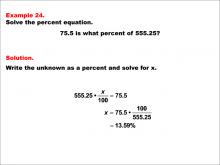
|
Math Example--Percents--Equations with Percents: Example 24 | Math Example--Percents--Equations with Percents: Example 24TopicSolving Equations DescriptionThis math example demonstrates solving percent equations by asking "75.5 is what percent of 555.25?" The solution involves setting up the equation 555.25 * (x / 100) = 75.5, then solving for x to get x = 75.5 * (100 / 555.25), which is approximately 13.59%. This example introduces a scenario where both the numerator and denominator are decimal numbers, resulting in a percentage that's less than 15%. |
Solving Percent Equations |
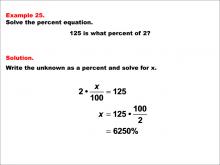
|
Math Example--Percents--Equations with Percents: Example 25 | Math Example--Percents--Equations with Percents: Example 25TopicSolving Equations DescriptionThis math example focuses on solving percent equations by asking "125 is what percent of 2?" The solution involves setting up the equation 2 * (x / 100) = 125, then solving for x to get x = 125 * (100 / 2), which equals 6250%. This example demonstrates how to calculate a percentage when the first number is significantly larger than the second, resulting in a percentage well over 100%. |
Solving Percent Equations |
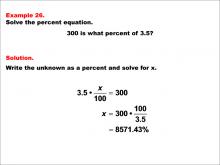
|
Math Example--Percents--Equations with Percents: Example 26 | Math Example--Percents--Equations with Percents: Example 26TopicSolving Equations DescriptionThis math example demonstrates solving percent equations by asking "300 is what percent of 3.5?" The solution involves setting up the equation 3.5 * (x / 100) = 300, then solving for x to get x = 300 * (100 / 3.5), which equals 8571.43%. This example introduces a scenario where the resulting percentage is extremely large, over 8000%, due to the first number being significantly larger than the small decimal base number. |
Solving Percent Equations |
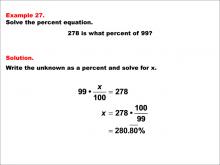
|
Math Example--Percents--Equations with Percents: Example 27 | Math Example--Percents--Equations with Percents: Example 27TopicSolving Equations DescriptionThis math example focuses on solving percent equations by asking "278 is what percent of 99?" The solution involves setting up the equation 99 * (x / 100) = 278, then solving for x to get x = 278 * (100 / 99), which equals 280.80%. This example demonstrates how to calculate a percentage when the first number is significantly larger than the second, resulting in a percentage greater than 200%. |
Solving Percent Equations |